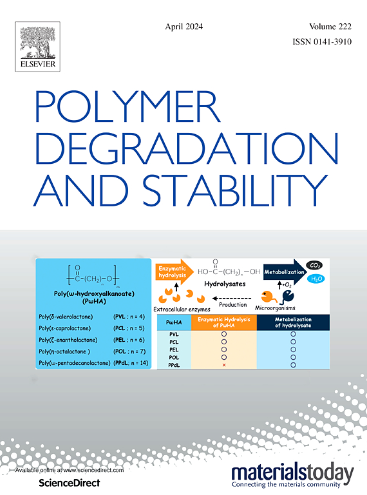亚麻植物组分的可燃性:从微观到实验规模的全植物研究
IF 7.4
2区 化学
Q1 POLYMER SCIENCE
引用次数: 0
摘要
采用热解-燃烧流动量热法和锥量热法研究了7种亚麻植物馏分的可燃性,即根、茎、碎纤维、束、细粒、种子和蒴果,以表征最具性能的馏分在火反应方面的特征。此外,研究人员还考虑了来自12个不同生长地点和发酵条件的亚麻品种的粉碎纤维,以评估其可燃性性能的可变性,并了解文献中观察到的结果的散射。少量且富含矿物质的细颗粒是最不易燃的部分,其放热量低(微尺度厌氧热解后为6.1 kJ/g),富矿物质残留物含量高(45 wt %)。相反,由于种子富含油脂,在燃烧过程中释放大量能量(19.6 kJ/g)。30% wt %)。此外,诸如亚麻品种、生长地点和沤制等变量对劈裂纤维的可燃性有显著影响,尽管这些因素各自的贡献不能轻易区分。本文章由计算机程序翻译,如有差异,请以英文原文为准。

Flammability of flax plant fractions: a whole-plant study from micro- to bench-scale
The flammability of a large set of 7 flax plant fractions, namely roots, shives, scutched fibres, tows, fines, seeds and capsules, has been studied using pyrolysis-combustion flow calorimetry and cone calorimetry in order to characterize the most performant fractions in terms of fire reaction. In addition, scutched fibres from twelve flax varieties with different growth locations and retting conditions have been considered to assess the variability of flammability properties and understand the scattering of results observed in the literature. The fines, produced in small amounts and rich in minerals, are the least flammable fraction, with a low heat release (6.1 kJ/g after anaerobic pyrolysis at microscale) and a high content of mineral-enriched residue (45 wt %). On the contrary, seeds release a large amount of energy (19.6 kJ/g) during combustion due to their oil-rich composition (> 30 wt %). In addition, variables such as flax variety, growth location and retting have a significant influence on the flammability properties of scutched fibres although the respective contributions of these factors cannot be easily discriminated.
求助全文
通过发布文献求助,成功后即可免费获取论文全文。
去求助
来源期刊

Polymer Degradation and Stability
化学-高分子科学
CiteScore
10.10
自引率
10.20%
发文量
325
审稿时长
23 days
期刊介绍:
Polymer Degradation and Stability deals with the degradation reactions and their control which are a major preoccupation of practitioners of the many and diverse aspects of modern polymer technology.
Deteriorative reactions occur during processing, when polymers are subjected to heat, oxygen and mechanical stress, and during the useful life of the materials when oxygen and sunlight are the most important degradative agencies. In more specialised applications, degradation may be induced by high energy radiation, ozone, atmospheric pollutants, mechanical stress, biological action, hydrolysis and many other influences. The mechanisms of these reactions and stabilisation processes must be understood if the technology and application of polymers are to continue to advance. The reporting of investigations of this kind is therefore a major function of this journal.
However there are also new developments in polymer technology in which degradation processes find positive applications. For example, photodegradable plastics are now available, the recycling of polymeric products will become increasingly important, degradation and combustion studies are involved in the definition of the fire hazards which are associated with polymeric materials and the microelectronics industry is vitally dependent upon polymer degradation in the manufacture of its circuitry. Polymer properties may also be improved by processes like curing and grafting, the chemistry of which can be closely related to that which causes physical deterioration in other circumstances.
 求助内容:
求助内容: 应助结果提醒方式:
应助结果提醒方式:


